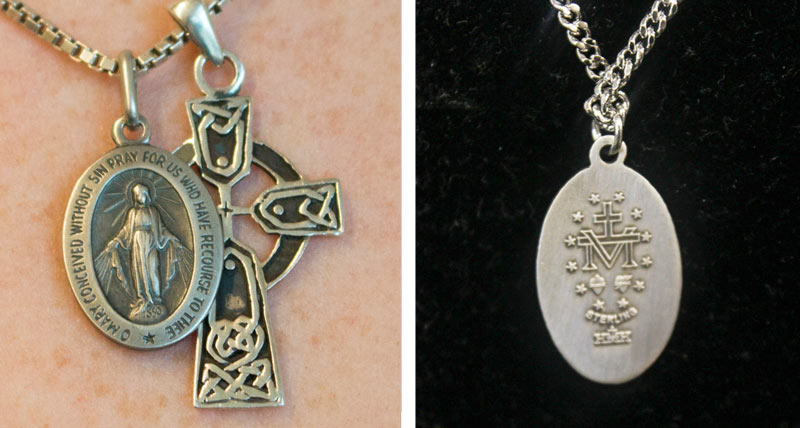
COLUMBIA—For 25 years, Laura Stamps has worn a special oval medal bearing a unique image of the Blessed Mother.
On it, Mary’s hands are extended downward and rays of light shine from them. On the back is the letter M, a cross and other sacred images.
Many people wear jewelry with Mary’s image on them, but the one Stamps wears has a unique history and has been an object of devotion for more than 180 years.
Stamps wears the Miraculous Medal, which some devotees describe as the “medal designed by the Blessed Mother herself.”
The images on it are said to have been requested by Mary when she appeared to a French nun in the 19th century. For generations since, millions have heeded the Blessed Mother’s request to wear the medallion and say the prayer on it.
The design is the result of appearances of the Blessed Mother to St. Catherine Laboure in France in 1830, while she was a member of the order of the Daughters of Charity.
St. Catherine wrote that during the second apparition, she saw Mary surrounded by an oval frame engraved with the words “O Mary conceived without sin, pray for us who have recourse to Thee.” Then, the frame bearing the prayer rotated and she saw the letter M with a cross on top of it, a circle of 12 stars, and below it the Sacred Heart of Jesus and Immaculate Heart of Mary.
“A voice said to me: ‘Have a medal struck upon this model. All those who wear it, when it is blessed, will receive great graces, especially if they wear it round the neck,’” the saint wrote, adding that the Blessed Mother told her that those who repeated the prayer on the frame would be under Mary’s protection, and many graces would be bestowed on those who believed.
St. Catherine said that at Mary’s request she described the vision and the images to a priest who was her confessor. After two years of investigation, he took the information to his archbishop and received approval to have the medals made. The original design was commissioned and produced by French goldsmith Adrien Vachette.
The jewelry quickly became popular in France and then throughout the world. By the time St. Catherine died in 1876, millions of them had been given out. They were first called the “Medal of the Immaculate Conception” but became known as the “Miraculous Medal” after healings, conversions, and other miraculous acts were claimed by those who wore it and said the prayer written on it.
St. Catherine and her visions are honored at the Chapel of Our Lady of Miraculous Medal in Paris, which is also the Motherhouse of the Daughters of Charity. The chapel marks the spots where the Blessed Mother is said to have appeared to St. Catherine.
In the U.S., a shrine to the Miraculous Medal can be found in the Germantown area of central Philadelphia, and a large shrine to her is also located at St. Mary’s of the Barrens Church in Perrysville, Mo.
Stamps has worn several versions over the years and currently wears one she purchased at St. Francis Catholic Shop in Columbia.
“I’ve always been especially devoted to Mary and I am a huge fan of this medal,” Stamps said. “You can feel the message of protection and healing that Our Lady said would be available to those who wore it.”
Miraculous medals come in a variety of shapes and sizes. Most Catholic shops carry versions in gold and silver, while others are set in blue or rose colored enamel. It is also worn as a charm on a bracelet or watch, or some people carry it in their pockets.
Members of the Legion of Mary frequently give out small, inexpensive versions in packets of other materials when they visit nursing homes and hospitals.
Theresa Freshwater, a member of the Legion of Mary at Our Lady of the Hills in Columbia, said she has worn one since high school and has seen its benefits firsthand. She tells the story of a woman in a nursing home who had fallen away from the Church and lost touch with her children. After Freshwater gave her the medal and a rosary during a visit, the woman became interested in the story and asked for a book about the life of St. Catherine. Shortly afterward, Freshwater said the woman requested to meet with a priest, go to confession and receive the Eucharist for the first time in years.
Freshwater loves the medallion not only for the graces it brings people who wear it, but the chance it gives her to spread the Gospel message.
“People see you wearing it and it starts conversations,” she said. “They want to know what it is and what it means. It gives you a chance to talk about the Church and about Mary. It’s a powerful medal and also a great evangelization tool.”


